Related Research Articles

Magnetic resonance imaging (MRI) is a medical imaging technique used in radiology to form pictures of the anatomy and the physiological processes inside the body. MRI scanners use strong magnetic fields, magnetic field gradients, and radio waves to generate images of the organs in the body. MRI does not involve X-rays or the use of ionizing radiation, which distinguishes it from computed tomography (CT) and positron emission tomography (PET) scans. MRI is a medical application of nuclear magnetic resonance (NMR) which can also be used for imaging in other NMR applications, such as NMR spectroscopy.

An impact event is a collision between astronomical objects causing measurable effects. Impact events have been found to regularly occur in planetary systems, though the most frequent involve asteroids, comets or meteoroids and have minimal effect. When large objects impact terrestrial planets such as the Earth, there can be significant physical and biospheric consequences, as the impacting body is usually traveling at several kilometres a second, though atmospheres mitigate many surface impacts through atmospheric entry. Impact craters and structures are dominant landforms on many of the Solar System's solid objects and present the strongest empirical evidence for their frequency and scale.
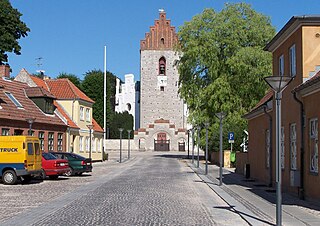
Stevns Municipality is a kommune in the Region Sjælland on the southeast coast of the island of Zealand in south Denmark. The municipality covers an area of 250 square kilometres (97 sq mi), and has a population of 23,692. The municipality covers most of Stevns Peninsula.

Functional magnetic resonance imaging or functional MRI (fMRI) measures brain activity by detecting changes associated with blood flow. This technique relies on the fact that cerebral blood flow and neuronal activation are coupled. When an area of the brain is in use, blood flow to that region also increases.
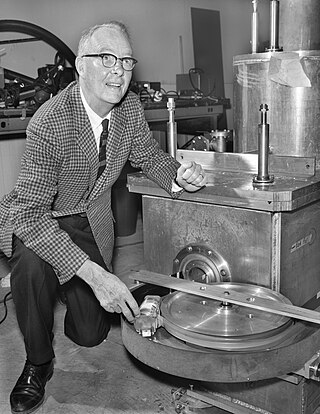
Luis Walter Alvarez was an American experimental physicist, inventor, and professor who was awarded the Nobel Prize in Physics in 1968 for his discovery of resonance states in particle physics using the hydrogen bubble chamber. In 2007 the American Journal of Physics commented, "Luis Alvarez was one of the most brilliant and productive experimental physicists of the twentieth century."

Catherine Ann Asaro is an American science fiction and fantasy author, singer and teacher. She is best known for her books about the Ruby Dynasty, called the Saga of the Skolian Empire.

An impact winter is a hypothesized period of prolonged cold weather due to the impact of a large asteroid or comet on the Earth's surface. If an asteroid were to strike land or a shallow body of water, it would eject an enormous amount of dust, ash, and other material into the atmosphere, blocking the radiation from the Sun. This would cause the global temperature to decrease drastically. If an asteroid or comet with the diameter of about 5 km (3.1 mi) or more were to hit in a large deep body of water or explode before hitting the surface, there would still be an enormous amount of debris ejected into the atmosphere. It has been proposed that an impact winter could lead to mass extinction, wiping out many of the world's existing species. The Cretaceous–Paleogene extinction event probably involved an impact winter, and led to mass extinction of most tetrapods weighing more than 25 kilograms.
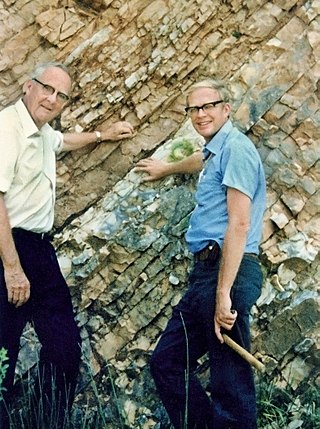
Walter Alvarez is a professor in the Earth and Planetary Science department at the University of California, Berkeley. He and his father, Nobel Prize–winning physicist Luis Alvarez, developed the theory that dinosaurs were killed by an asteroid impact.
The year 1977 in science and technology involved some significant events, listed below.

John Bannister Goodenough was an American materials scientist, a solid-state physicist, and a Nobel laureate in chemistry. From 1986 he was a professor of Mechanical, Materials Science, and Electrical Engineering at the University of Texas at Austin. He is credited with identifying the Goodenough–Kanamori rules of the sign of the magnetic superexchange in materials, with developing materials for computer random-access memory and with inventing cathode materials for lithium-ion batteries.

The Alvarez hypothesis posits that the mass extinction of the non-avian dinosaurs and many other living things during the Cretaceous–Paleogene extinction event was caused by the impact of a large asteroid on the Earth. Prior to 2013, it was commonly cited as having happened about 65 million years ago, but Renne and colleagues (2013) gave an updated value of 66 million years. Evidence indicates that the asteroid fell in the Yucatán Peninsula, at Chicxulub, Mexico. The hypothesis is named after the father-and-son team of scientists Luis and Walter Alvarez, who first suggested it in 1980. Shortly afterwards, and independently, the same was suggested by Dutch paleontologist Jan Smit.

Neuroimaging is the use of quantitative (computational) techniques to study the structure and function of the central nervous system, developed as an objective way of scientifically studying the healthy human brain in a non-invasive manner. Increasingly it is also being used for quantitative research studies of brain disease and psychiatric illness. Neuroimaging is highly multidisciplinary involving neuroscience, computer science, psychology and statistics, and is not a medical specialty. Neuroimaging is sometimes confused with neuroradiology.
The neocognitron is a hierarchical, multilayered artificial neural network proposed by Kunihiko Fukushima in 1979. It has been used for Japanese handwritten character recognition and other pattern recognition tasks, and served as the inspiration for convolutional neural networks.
The term iridium anomaly commonly refers to an unusual abundance of the chemical element iridium in a layer of rock strata at the Cretaceous–Paleogene (K–Pg) boundary. The unusually high concentration of a rare metal like iridium is often taken as evidence for an extraterrestrial impact event.
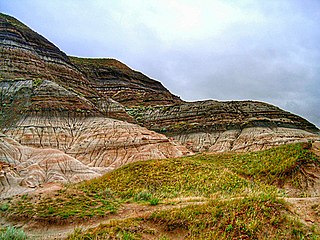
The Cretaceous–Paleogene (K–Pg) boundary, formerly known as the Cretaceous–Tertiary (K–T) boundary, is a geological signature, usually a thin band of rock containing much more iridium than other bands. The K–Pg boundary marks the end of the Cretaceous Period, the last period of the Mesozoic Era, and marks the beginning of the Paleogene Period, the first period of the Cenozoic Era. Its age is usually estimated at 66 million years, with radiometric dating yielding a more precise age of 66.043 ± 0.011 Ma.
Kunihiko Fukushima is a Japanese computer scientist, most noted for his work on artificial neural networks and deep learning. He is currently working part-time as a senior research scientist at the Fuzzy Logic Systems Institute in Fukuoka, Japan.
Cultural neuroscience is a field of research that focuses on the interrelation between a human's cultural environment and neurobiological systems. The field particularly incorporates ideas and perspectives from related domains like anthropology, psychology, and cognitive neuroscience to study sociocultural influences on human behaviors. Such impacts on behavior are often measured using various neuroimaging methods, through which cross-cultural variability in neural activity can be examined.

Frank Asaro was an Emeritus Senior Scientist at the Lawrence Berkeley National Laboratory associated with the University of California at Berkeley. He is best known as the chemist who discovered the iridium anomaly in the Cretaceous–Paleogene boundary layer that led the team of Luis Alvarez, Walter Alvarez, Frank Asaro, and Helen Michel to propose the Asteroid-Impact Theory, which postulates that an asteroid hit the Earth sixty-five million years ago and caused mass extinction during the age of the dinosaurs.
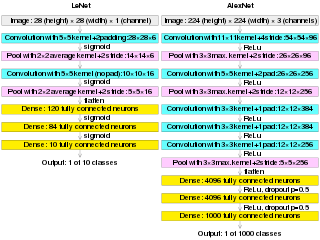
AlexNet is the name of a convolutional neural network (CNN) architecture, designed by Alex Krizhevsky in collaboration with Ilya Sutskever and Geoffrey Hinton, who was Krizhevsky's Ph.D. advisor at the University of Toronto.
The history of magnetic resonance imaging (MRI) includes the work of many researchers who contributed to the discovery of nuclear magnetic resonance (NMR) and described the underlying physics of magnetic resonance imaging, starting early in the twentieth century. One researcher was American physicist Isidor Isaac Rabi who won the Nobel Prize in Physics in 1944 for his discovery of nuclear magnetic resonance, which is used in magnetic resonance imaging. MR imaging was invented by Paul C. Lauterbur who developed a mechanism to encode spatial information into an NMR signal using magnetic field gradients in September 1971; he published the theory behind it in March 1973.
References
- ↑ Mizushima, K.; Jones, P. C.; Wiseman, P. J.; Goodenough, J. B. (June 1980). "LixCoO2 (0<x≪-1): A new cathode material for batteries of high energy density". Materials Research Bulletin. 15 (6): 783–789. doi:10.1016/0025-5408(80)90012-4. S2CID 97799722.
- ↑ Dronsfield, Alan (January 2011). "Inorganic Chemical Laboratory, Oxford/John Goodenough Landmark Award" (PDF). RSC Historical Group Newsletter. Royal Society of Chemistry: 25–27. Archived from the original (PDF) on 2015-09-24. Retrieved 2012-01-17.
- ↑ "Cern Authentication". ref.web.CERN.ch. Retrieved January 8, 2018.
- ↑ Bellis, Mary. "IBM History". About.com. Archived from the original on April 27, 2012. Retrieved 2011-11-30.
- ↑ Aamidor, Abe. "Thank this guy for 'control-alt-delete'". The Indianapolis Star . Archived from the original on 2017-09-10. Retrieved 2011-11-30.
- ↑ Searle, John (1980). "Minds, brains, and programs". Behavioral and Brain Sciences . 3 (3): 417–424. doi:10.1017/s0140525x00005756. S2CID 55303721 . Retrieved 2009-05-13.
- ↑ Lueg, Christopher; Fisher, Danyel, eds. (2003). From Usenet to CoWebs: interacting with social information spaces. London: Springer. ISBN 978-1-85233-532-8.
- ↑ Fukushima, Kunihiko (1980). "Neocognitron: A Self-organizing Neural Network Model for a Mechanism of Pattern Recognition Unaffected by Shift in Position" (PDF). Biological Cybernetics. 36 (4): 193–202. doi:10.1007/bf00344251. PMID 7370364. S2CID 206775608 . Retrieved 2013-12-10.
- ↑ Ciresan, Dan; Meier, Ueli; Schmidhuber, Jürgen (June 2012). "Multi-column deep neural networks for image classification". 2012 IEEE Conference on Computer Vision and Pattern Recognition. New York: Institute of Electrical and Electronics Engineers. pp. 3642–3649. arXiv: 1202.2745 . doi:10.1109/CVPR.2012.6248110. ISBN 9781467312264. OCLC 812295155. S2CID 2161592.
- ↑ Alvarez, Luis W.; Alvarez, Walter; Asaro, Frank; Michel, Helen V. (1980). "Extraterrestrial cause for the Cretaceous–Tertiary extinction". Science . 208 (4448): 1095–1108. Bibcode:1980Sci...208.1095A. CiteSeerX 10.1.1.126.8496 . doi:10.1126/science.208.4448.1095. PMID 17783054. S2CID 16017767.
- ↑ "John Mallard". Profiles. 2021-02-27. Archived from the original on 2020-10-22. Retrieved 2021-02-27.
- ↑ Borel, J. F.; Kis, Z. L.; Beveridge, T. (2012). "2: The History of the Discovery and Development of Cyclosporine". In Merluzzi, Vincent J.; Adams, Julian (eds.). The Search for Anti-Inflammatory Drugs: Case Histories from Concept to Clinic. Springer Science & Business Media. p. 58. ISBN 978-1-4615-9848-0.
- ↑ Valentine, Vincent (June 2017). "Recapitulation of the Opening Plenary Session: San Diego 2017" (PDF). Links. ISHLT. Retrieved 2018-07-28.
- ↑ Mayes, R.; Horwitz, A. V. (2005). "DSM-III and the revolution in the classification of mental illness". Journal of the History of the Behavioral Sciences. 41 (3): 249–67. doi:10.1002/jhbs.20103. PMID 15981242.
- ↑ Wilson, M. (1993). "DSM-III and the transformation of American psychiatry: a history". American Journal of Psychiatry . 150 (3): 399–410. doi:10.1176/ajp.150.3.399. PMID 8434655.
- ↑ Spiegel, Alix (2005-01-03). "The Dictionary of Disorder: How one man revolutionized psychiatry". The New Yorker . pp. 56–63. Archived from the original on 6 June 2011. Retrieved 2011-06-04.
- ↑ "MRI Scanner (1980)". Oxfordshire Blue Plaques Scheme. Oxfordshire Blue Plaques Board. 2011-06-02. Retrieved 2012-01-06.
- ↑ Geggel, Laura (2018-12-11). "'Miracle' Excavation of 'Little Foot' Skeleton Reveals Mysterious Human Relative". Live Science . Retrieved 2018-12-11.